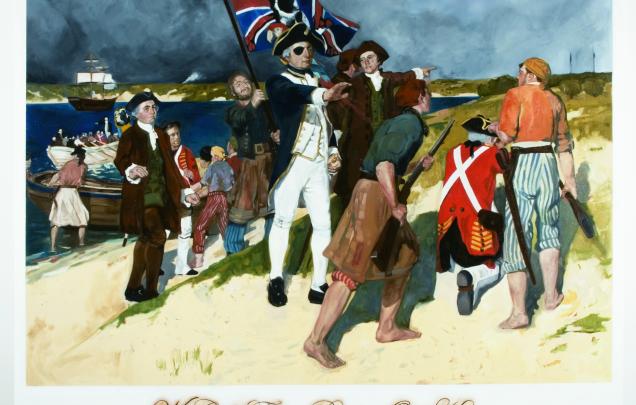A modern response to Cook
Through an examination of contemporary and historical artworks, students analyse and evaluate the ways in which art presents an alternative perspective. Students will think interpretively and discerningly about the ways that visual features and the composition of contemporary artworks can be used to challenge society’s beliefs and assumptions about Cook’s arrival at Kamay (Botany Bay).
This is the student activity 1 of 1 of the Eight days in Kamay – texts and the human experience learning activity.

Who was Captain Cook?
View Chapter 3 of the online exhibition, here.
Look at your earlier response to the question: ‘What I know about Cook.’ How has your exploration of Chapter 3 of the online exhibition altered your perspective on Cook? Share your thoughts with a partner. Ask each other which features of the online exhibition were the most eye-opening for you.
A different perspective
Pirate? Hero? Both? Neither? The way James Cook is remembered in Australia remains deeply contested.
View the painting Landing of Captain Cook at Botany Bay 1770 by E Phillips Fox, 1902, in the exhibition, here.
Form groups to analyse how Cook is portrayed in this painting. Each group is assigned one of the following visual features to present to the rest of the class: framing, composition, salience, colour and symbolism.
Discuss the purpose of the painting, created by E Phillips Fox in 1902. What is he trying to achieve? What was happening in Australia at the time? What is his perspective on Cook and his arrival at Kamay (Botany Bay)?
View We Call them Pirates Out Here by Daniel Boyd, 2006, found in the exhibition, here.
Watch the interview with Daniel Boyd, the artist who created We Call Them Pirates Out Here.
Write a review of Daniel Boyd’s painting to be published in an art magazine. Imagine you are writing when the artwork was first put on display. In the review analyse the artist’s purpose and how the recreation of the earlier painting Landing of Cook at Botany Bay 1770 works to ignite new ideas about what happened when Cook arrived on April 29, 1770.
Discuss why these contrasting paintings have been selected for inclusion in the online exhibition Eight Days in Kamay. What is the effect on the viewer’s perception of the first contacts between Cook and the crew on the Endeavour and the Gweagal people of Kamay (Botany Bay)?
What if?
View Cook’s Dinner Party by Vincent Namatjira, 2014 found in the exhibition, here. Scroll down to read more about this artwork in an analysis written by Arrernte writer and social commentator Celeste Liddle.
Discuss the use of humour in the painting. Firstly, identify aspects of the painting that may be considered humorous and discuss why. Humour can be used as a technique in art to highlight issues in an accessible way for viewers. It can also be an acceptable and palatable way within society for artists to express themselves on a serious issue, as opposed to art that is more shocking, confronting and graphic. A viewer’s discomfort from having their beliefs and understandings challenged can be eased through humour.
Evaluate the effectiveness of using dark humour in this work by Vincent Namatjira. Write an analysis of the painting to be included in a brochure that will be available for visitors to the gallery where this piece is on display. In this analysis you should include the purpose of using humour when dealing with a sensitive issue.